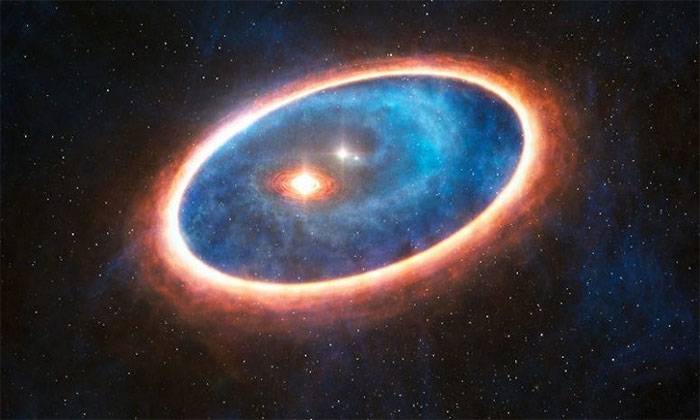The 'eat' star companion in binary
Computer simulations reveal how a massive star draws matter from a smaller star orbiting it at close distances.

Simulate binary star system.(Photo: ESO).
Experts at the Center for Gravitational Wave Detection (OzGrav) of the Australian Research Council in collaboration with the Max Planck Institute in Germany, Monash University in Australia and the University of Birmingham, UK, conducted an understanding of the origin of the features of the Be X-ray binary in a dwarf galaxy called the Small Magellanic Cloud .
The Be X-ray binary is a star system consisting of a neutron star orbiting a fast rotating massive star. This motion causes the big star to create a physical disk. The neutron star then fires off X-ray radiation that scientists can observe and measure.
Dr. Serena Vinciguerra, lead researcher at OzGrav, uses COMPAS to simulate an environment similar to the Small Magellan Cloud. By comparing the orbital characteristics of simulated Be X-ray binary star systems with observed systems, the team was able to discover their evolution.
Initially, two stars formed in binary systems have a narrow orbit. The biggest mass stars evolve faster and expand. Due to its proximity, the massive star swells matter from the smaller star. At the end of evolution, the massive star exploded as a supernova, leaving behind a small but very dense neutron star. If both stars exist after the explosion, they will form a Be X-ray system.
- The unique binary star system is extremely rare in the universe
- The first white dwarf detected in a binary system
- The giant red star revives 'zombie star' that confuses the researcher
- Does life exist in a binary star system?
- Discover a mysterious companion star
- Mysterious binary star systems
- Detecting a companion system of three stars
- Unique binary star system is extremely rare in the universe
- The star is brighter than the Sun.
- Detecting super-fast star systems disrupts conventional physics theory
- The first white dwarf detected in a binary system
- The first time discovered the water drop star
- New hypothesis about a strange binary star system
- Three-star star system
 Van Allen's belt and evidence that the Apollo 11 mission to the Moon was myth
Van Allen's belt and evidence that the Apollo 11 mission to the Moon was myth The levels of civilization in the universe (Kardashev scale)
The levels of civilization in the universe (Kardashev scale) Today Mars, the sun and the Earth are aligned
Today Mars, the sun and the Earth are aligned The Amazon owner announced a secret plan to build a space base for thousands of people
The Amazon owner announced a secret plan to build a space base for thousands of people